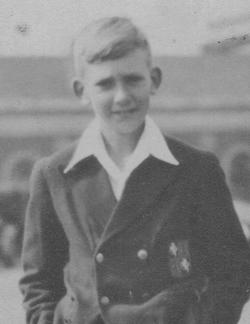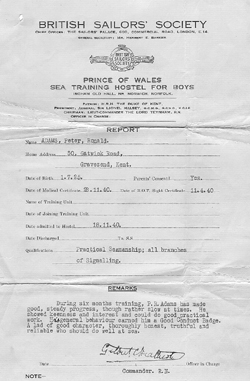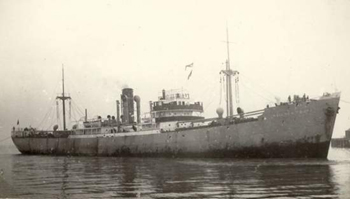Peter Ronald Adams
/back
 Peter
Ronald Adams was born in Greenhithe Kent on 1/7/1925 and grew up in Gravesend he
joined the PWSTS in November 1940 at the age of 15 years. His interest in going
to sea was in no doubt due to his Grandfather, who was a Master Mariner and
Lighterman. Peter's first ship after leaving the PWSTS was the SS Hawkinge which
he joined on the 20th of July 1941, on the 27th of July 1941 the Hawkinge was
sunk by U-203 while sailing in convoy OG 69 (details of ship and convoy below).
Peter
Ronald Adams was born in Greenhithe Kent on 1/7/1925 and grew up in Gravesend he
joined the PWSTS in November 1940 at the age of 15 years. His interest in going
to sea was in no doubt due to his Grandfather, who was a Master Mariner and
Lighterman. Peter's first ship after leaving the PWSTS was the SS Hawkinge which
he joined on the 20th of July 1941, on the 27th of July 1941 the Hawkinge was
sunk by U-203 while sailing in convoy OG 69 (details of ship and convoy below).
Peter's next ship was the Tanker British
Princess which he joined at Tilbury and sailed to Fremantle being discharged on
the 3rd of January 1942. I have no information on how this voyage went other
than he obviously made it to Australia.
His next ship doesn't appear in his discharge book, he joined ... what looks
like the Zaanlano or Zaanland on the 20th of March 1942, I have no details of
this Ship or it's voyage.
And finally Peters last ship the SS Nailsea Court which he joined on the 18th of
June 1943 at Tilbury, details of the Nailsea Court and a very interesting
account of her sinking and the events that lead to the loss of my Uncle are
below.
Name Hawkinge
Type: Steam merchant
Tonnage 2,475 tons
Completed 1924 - Burntisland Shipbuilding Co Ltd, Burntisland
Owner Halford Constants Ltd, London
Homeport London
Date of attack 27 Jul, 1941 Nationality: British
 Fate
Sunk by U-203 ( Rolf Mützelburg)
Fate
Sunk by U-203 ( Rolf Mützelburg)
Position 44.55N, 17.44W - Grid BE 8295
- See location on a map -
Complement 31 (15 dead and 16 survivors).
Convoy OG-69
Route Glasgow - Lisabon
Cargo 2806 tons of coal
History completed in August 1924 as Pentraeth for Lambert Barnett & Co, London.
1932 renamed Hawkinge for Halford Constants Ltd, London.
Notes on loss At 02.54 hours on 27 Jul, 1941, U-203 attacked the convoy OG-69
about 800 miles southwest of Fastnet and reported the sinking of two ships,
totalling 14.000 grt. However, only the Hawkinge (Master Walter Aron Isaksson)
was hit. 13 crew members and two gunners were lost. The master and five crew
members were picked up by HMS Sunflower (K 41) (LtCdr J.T. Jones, RNR) and
landed at Londonderry. Seven crew members and three gunners were picked up by
HMS Vanoc (H 33) (LtCdr J.G.W. Deneys, DSO, RN) and landed at Liverpool.
Convoy battles
OG-69
United Kingdom - Gibraltar (North Atlantic)
24 Jul, 1941 - 30 Jul, 1941
The Convoy
First sighting On 24 Jul, 1941 by U-68
Escorts
U-boats
U-79*, U-126 *, U-331, U-68, U-561 *, U-562, U-203 * and U-564 (briefly)
* U-boats that fired torpedo or used the deck gun
The battle
The convoy was located by B-Dienst, the German intelligence service, on 24 July
and then confirmed by Fw-200 Condor aircraft. Initially 8 U-boats are directed
towards it while another 6 boats are vectored against the SL.80 located the same
day. The SL.80 escapes and the operation is withdrawn on the 26th. Actual U-boat
contact is only on the 26th at 1745hrs, when U-68 finds the convoy after Fw-200
guidance. Between 1930 and 2040hrs U-79, U-371 and U-561 reached the convoy.
U-79 attacked then as first U-boat in the early morning of 27th. In the same
time U-331 also reached the convoy, but was forced aside by the escorts. 2 hours
later arrived U-126 and U-203, which sunk immediate a ship. At 0330hrs were U79
and U-203 attacked from the escorts with depth charges. The U-boats shadowed the
convoy in the daylight of 27th and attacked once more in the night. Last attack
shot U-203 in the evening of the 28th. Last contact had Tiesenhausen's U-331 in
the morning of 29th. 8 ships are sunk for 12,762 tons, no additional ships are
damaged. The U-boats shooted 25 torpedoes and were attacked 6 times with depth
charges and 2 times with guns. Only U-562 was damaged after an attack with depth
charges and had to leave for heading home.
Overview of Events - ss Nailsea Court
 The
ss Nailsea Court was owned by E.R. Management Co. LTD (Evans & Reid) - Cardiff
and was built in 1936 by the Bantham Steamship Co. Ltd. Her GRT was 4946.
The
ss Nailsea Court was owned by E.R. Management Co. LTD (Evans & Reid) - Cardiff
and was built in 1936 by the Bantham Steamship Co. Ltd. Her GRT was 4946.
Her last voyage was as part of Convoy SC 121
which comprised of 57 ships. The passage was from Beira to New York 23.2.43 and
then London. She was carrying 2 passengers and 7661 tons of general cargo
including 650 tons of copper bars, 800 tons of nickel ore and asbestos.
On the 10/3/43 she was torpedoed and sunk by U-229 (Oberleutant Schetelig), part
of the 'Ostmark' patrol group of eleven U-boats, in the Atlantic S of Reykjavik,
in position 58.45N 21.57W.
The Master, Capt. Robert James Lee (aged 46 and from Penarth, South Wales), 33
crew, 9 gunners and passengers were lost. 1 crew was rescued by the rescue ship
Melrose Abbey 1908/29 (Capt Ralph Good OBE) and landed at Gourock 13.3.43; 3
crew by RCN corvette Dauphin 925/40 (K.157) (Lt M.H. Wallace) and landed at
Londonderry 13.3.43.
Oberleutnant zur See Robert Schetelig and his crew of 49 were subsequently lost
in the North Atlantic on the 22nd September 1943 when the U-229, then part of
the 'Leuthen' patrol group of nineteen U-boats, was sunk by depth charges,
gunfire and ramming while attacking convoy ON 202 comprising 38 ships in the
Atlantic 430 miles ESE of Cape Farewell, in position 54.36N 36.25W by HM
destroyer leader Keppel 1750/20 (D.84) (Cdr M.J.Evans) of Escort Group B.
Commander Evans was subsequently lost in action on the 7th May 1944.
The following is an exact reproduction of the text of an official casualty
report provided by the only surviving officer of the ss Nailsea Court, Mr HCC
Bette
23rd March 1943
SHIPPING CASUALTIES SECTION – TRADE DIVISION
REPORT OF AN INTERVIEW WITH THE 2nd ENGINEER, Mr HCC BETTE
ss “NAILSEA COURT” - - 4946 gt
IN CONVOY S.C.121
All Times are convoy Times
+2 hrs, 20 mins for G.M.T.
Mr H C Bette:
1. We sailed from New York bound for Loch Ewe with a cargo of 6500 tons of
Copper Bars, 800 tons of Nickal Ore and Asbestos, We were armed with 1-4”,
12pdr, 4 machine guns, and 4 PAC Rockets. The crew including 4 Army and 5 Navy
Gunners, numbered 49; there were in addition 2 passengers, one a mining
engineer, the other an Electrical Engineer, who came on borad at Freetown. Of
this number 48 are missing, including all officers (with the exception of
myself), the gunners, and the two passengers. I cannot say with certainty, but I
am of the opinion that all confidential and wireless books were thrown overboard
in a weighted box. We did not carry any mails. Degaussing was off.
2. We left New York on the 27th February, 1943 and joined up with convoy
S.C.121, our position being No 24, the 4th ship in the 2nd column.
3. The convoy proceeded without incident until the 7th March, when between 2100
and 2400 an attack was made and 3 ships were torpedoed. A further attack was
made the following night, at about the same time, resulting in the loss of
another 5 ships. On the 9th March, another attack kept us at ‘alert stations’
from 1945. I think a further 5 ships had been torpedoed, when at 2145, whilst
steaming at 7 and a half knots, in position 58 degree 45’N, 21 degrees 57’W, we
were struck by 2 torpedoes. The weather was very bad with frequent hail squalls,
visibility poor, very rough sea with a heavy swell, S.E. gale force 7.
4. The first torpedo struck in No 1 hold on the port side with a dull explosion.
I was in my accommodation, and at first thought there had been a collision, so
made my way down the ladder, about a minute and a half later, the 2nd torpedo
struck. This also was a very dull explosion, but being below I do not know
whether a column of water was thrown up, or if there was a flash, or smell;
neither could I tell the actual dock damage sustained. The second torpedo struck
in the port side of the No 2 hold. Both torpedoes hit forward, the hatches from
No.1 hold being blown off by the first explosion. I did not hear of anyone
seeing the tracks of either of the torpedoes.
5. I continued on my way to the engine room, where I found everything in order,
there being no sign of water leaking through. The 4th Engineer, Mr E.R. Dryden,
and the Fireman Barnes, were still in their posts in the Engine-room, so we
stopped the engines, also the circulating pump, as one lifeboat was directly
over the discharge outlet and I did not wish to fill the boat up. The order was
given on the telegraph to “abandon ship” three minutes after the second
explosion.
6. I went up onto the boat deck, and saw that the starboard motor-boat was
damaged, During the previous day the port boat had been struck by a heavy sea,
and washed inboard where it had been secured, thus leaving only the starboard
boat intact and this was ultimately very much overloaded. There was some delay
in lowering this boat, as the forward fall became jammed, and one of the sailors
who was trying to clear it got his hand in the block. The 2nd Officer, Mr
Johasen, assisted by the crew, eventually managed to lift the boat and release
the man’s hand. As the falls were cleared the Captain ordered “abandon ship” and
the crew lowered the boat into the water. This starboard boat eventually had 25
men in it, and the remainder had to get away in the rafts. Captain Lee, 2nd
Officer Mr Johasen, an Apprentice and myself were left on board, so all four of
us jumped from the boat deck, the Captain being the last to jump as the ship
sank. I saw her stern lift completely out of the water, and she finally plunged
straight down by the head, without listing, 12 minutes after being torpedoed. No
wireless message was sent out, and no rockets were fired, but later we flashed
distress messages from the lifeboat with a torch.
7. About the same time as we were torpedoed, the Commodore’s ship “Bonneville”
and the SS “Coulmore” were also torpedoed and I should think that the attacks
occurred at intervals of between ¾ minutes. The “Coulmore” was originally astern
of us on the port side, in the position of No.15 and was struck on the port
side, but she was on our starboard side when she sank.
8. I managed to get into the lifeboat, and after picking up several men from the
water, some of whom I think were from the “Coulmore”, there were 37 men in the
boat. She became water-logged, and although we did our best to bale her out,
with such heavy sea it was impossible to keep her dry. The Canadian Corvette
“Dauphon” which came over to rescue us suddenly stopped when she was about 250
yards from us. The Captain shouted through his loud hailer telling us that his
steering gear had broken down, and that he was unable to reach us. We signalled
telling him that our boat was sinking rapidly. Again, the Captain told us that
he could not possibly reach us and that we were to try and reach him. This, of
course, was quite impossible owing to the crowed condition of our boat, and
about half an hour later it capsized. Up to this time our Captain was in the
boat with us, but I do not remember seeing him afterwards. Many of the men were
exhausted and washed away by the heavy seas until eventually there were only 17
left, clinging to the keel of the upturned boat. Gradually many of these men
were washed away until finally there were only 7 of us left. At approximately
0200 on the 10th March, the Corvette came along for the second time. We had now
been hanging onto the bottom of the boat for about three and a half hours; only
another man and myself were strong enough to lift our hands in order to be
dragged aboard as the Corvette came along – the remaining men must have either
been unconscious or too exhausted to lift their hands, or perhaps they feared
that once they let go of the keel they would be washed away. There were also two
men on the port raft, but only one was rescued, the other already being dead. I
was in fairly good condition although obviously weak from exposure after my
ordeal, but in about half an hour I recovered and was soon myself again. The 3
survivors rescued by the Corvette were the Messroom steward, a greaser named
Perks and myself. It was due to the failure of the steering gear of the Corvette
that so many of our men lost their lives. We were eventually landed at
Londonderry at 0800 on the 13th March 1943.
9. Owing to the frequency of the attacks, prior to the disaster, the boat’s
wireless set was placed in the port boat in readiness, but this boat did not get
away.
10. I would suggest that as the lifeboats frequently capsize, a rail fitted
along each side of the keel would greatly assist men to hang on to the bottom of
the upturned boats. In cold weather it is extremely difficult to hang on to the
keel which is so wide that it is impossible to grip it tightly.
11. I would like to mention that all the crew behaved extremely well, and that
there was definitely no sign of panic. Very special mention is due to the 2nd
officer Mr Johanson (a Norwegian naturalised British) whose behaviour was
outstanding throughout. He lead and encouraged the crew during the abandoning
ship operation, remaining behind in order to lower the lifeboat, and was an
inspiration to all. His unselfish action cost him his life.
12. I would also specifically mention the magnificent bearing and behaviour of
Captain Lee, who remained behind until the end, encouraging the crew and
attending to the lowering of the boat. Whilst in the boat his splendid bearing
gave confidence and encouragement to everybody. Unfortunately, he was washed out
of the boat and was drowned.
13. I would also specially mention 4th Engineer Dryden, Greaser Perks, and
Fireman Barnes, who were on watch in the engine-room when the 1st torpedo
struck. They remained at their posts even when the second torpedo struck the
ship, and still remained to stop the main engines and circulating pump, this
preventing the lifeboat from being filled with the overside discharge water.
Thanks go to David Lee and his Web site
www.nailseacourt.co.uk
Tim
Adams
 Peter
Ronald Adams was born in Greenhithe Kent on 1/7/1925 and grew up in Gravesend he
joined the PWSTS in November 1940 at the age of 15 years. His interest in going
to sea was in no doubt due to his Grandfather, who was a Master Mariner and
Lighterman. Peter's first ship after leaving the PWSTS was the SS Hawkinge which
he joined on the 20th of July 1941, on the 27th of July 1941 the Hawkinge was
sunk by U-203 while sailing in convoy OG 69 (details of ship and convoy below).
Peter
Ronald Adams was born in Greenhithe Kent on 1/7/1925 and grew up in Gravesend he
joined the PWSTS in November 1940 at the age of 15 years. His interest in going
to sea was in no doubt due to his Grandfather, who was a Master Mariner and
Lighterman. Peter's first ship after leaving the PWSTS was the SS Hawkinge which
he joined on the 20th of July 1941, on the 27th of July 1941 the Hawkinge was
sunk by U-203 while sailing in convoy OG 69 (details of ship and convoy below).
 The
ss Nailsea Court was owned by E.R. Management Co. LTD (Evans & Reid) - Cardiff
and was built in 1936 by the Bantham Steamship Co. Ltd. Her GRT was 4946.
The
ss Nailsea Court was owned by E.R. Management Co. LTD (Evans & Reid) - Cardiff
and was built in 1936 by the Bantham Steamship Co. Ltd. Her GRT was 4946.